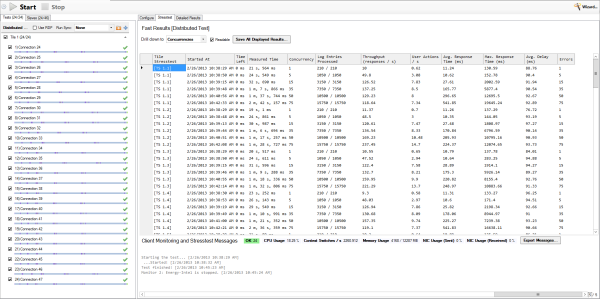Calxeda's ARM server tested
by Johan De Gelas on March 12, 2013 7:14 PM EST- Posted in
- IT Computing
- Arm
- Xeon
- Boston
- Calxeda
- server
- Enterprise CPUs
Our Real World Test
We've set up two systems, the Xeon system with two different pairs of Xeon CPUs, 128GB and ESXi 5.1. We created 24 virtual machines on top of the Xeon server. Inside each we have a PhpBB (Apache2, MySQL) website with four virtual CPUs and 4GB RAM. The website uses about 8GB of disk space. We simulate up to 75 concurrent users that send new requests every 0.6-2.4 seconds.
The Boston Viridis server gets the same workload, but instead of using virtual machines, we used the 24 physical server nodes.
Since the redesign in late 2010, our vApus stresstesting framework is well suited to hit (virtualized or not) clusters with lots of workloads in parallel. A quad 7400 server is able to spawn 24 testing clients. The server is connected to our Dell PowerConnect 8024F (10Gbit Ethernet), which is connected to the testservers.
vApus hitting 24 web servers in parallel
This way we can simulate a webhosting environment where tens of websites are hit by a few thousands of visitors per second. That might not sound very impressive, but those few thousand requests per second result in a web environment with 100 million hits per day.
Since we made sure that our web server serves up some nice pictures (png), there is some significant network traffic going on. We measured peaks of up to 8Gbit/s, with typical network traffic being about 4 to 6Gbit/s.











99 Comments
View All Comments
tuxRoller - Tuesday, March 12, 2013 - link
Why WOULD you expect DVFS to boost performance?You seem to think it slightly revelational that the scores are slightly lower (but perhaps statistically meaningless).
dig23 - Tuesday, March 12, 2013 - link
On-demand seems fair choice to me, its what best you can do on this OSes. But I will be very interested to see energy efficiency numbers when DVFS working on swarm of ARM nodes...:)tuxRoller - Tuesday, March 12, 2013 - link
It's not cpu governor I'm talking about but DVFS in particular.There's bound to be some small amount of latency involved with the process.
It's point isn't for best performance but energy efficiency thus why I made the comment in the first place.
JarredWalton - Tuesday, March 12, 2013 - link
There's the potential for DVFS to optimize for better performance on a few cores while putting some of the other cores into a lower P-state, but I think that would be more for stuff like Turbo Boost/Turbo Core. It's also possible Johan is referring to the potential for the optimizations to simply improve performance in general.CodyHall - Friday, March 15, 2013 - link
Love my job, since I've been bringing in $5600… I sit at home, music playing while I work in front of my new iMac that I got now that I'm making it online.(Click Home information)http://goo.gl/9u8us
JohanAnandtech - Wednesday, March 13, 2013 - link
Can you tell me where I got you confused? Because I write "This allowed us to make use of Dynamic Voltage and Frequency Scaling (DVFS, P-states) using the CPUfreq tool. First let's see if all these power saving tweaks have reduced the total throughput."So it should been clear that we are looking for a better performance/watt ratio. The interesting thing to note is that ARM benefits from p-states, and that Intel's excellent implementation of C-states makes p-states almost useless.
Twonky - Wednesday, March 13, 2013 - link
For information about a year ago the following post on the Linkedin ARM Based Group gave a link to a M.Sc. thesis publishing figures on the performance/watt ratio for Cortex-A8 and Cortex-A9 based boards:www.linkedin.com/groups/Single-CortexA8-CortexA9-in-comparison-85447.S.84348310
AncientWisdom - Tuesday, March 12, 2013 - link
Very interesting read, thanks!staiaoman - Tuesday, March 12, 2013 - link
Damn, Johan. As always- an incredible writeup. Interesting thought experiment to figure that an upper bound on damage to INTC server share might be found by simply looking at how much of the market is running applications like your web server here (where single-threaded performance isn't as important).Intel powering phones and ARM chips in servers...the end is nigh.
JohanAnandtech - Thursday, March 14, 2013 - link
Thanks Staiaoman :-). I'll leave the though experiment to you :-)